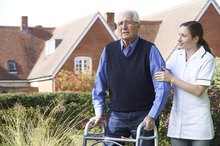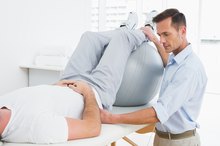Can I Exercise With a Deep Vein Thrombosis?
A common risk of surgery is deep vein thrombosis. DVT is a blood clot that typically develops in the lower extremity, usually in the thigh or the calf. Bed rest and immobility promote stasis of the blood and are main factors in the development of DVT. Those at risk for developing DVT include post-operative patients and those who lead sedentary lifestyles are also at risk. In the past, once you were diagnosed with DVT, strict bed rest was ordered to prevent the clot from dislodging into your lungs, causing a pulmonary embolism, or PE, a fatal complication of DVT. However, that recommendation may be changing due to research that suggests early mobility with DVT may not be as risky as once thought. In fact, it may be beneficial.
Research
In several studies looking at early mobility after DVT, patients began walking under supervision either immediately after being diagnosed and starting blood thinners and compression therapy such as compression stockings, or on the second day after beginning treatment. According to the website of Investigators Against Thrombo-Embolism, or INATE, these patients were no more likely to develop a PE in the upcoming days and months than patients who were initially ordered to stay in bed.
Benefits
Deep Vein Thrombosis & Physical Therapy
Learn More
DVT symptoms such as swelling and pain may clear up more quickly in patients encouraged to be mobile. According to INATE, it is possible that mobility can help prevent persistent calf symptoms after DVT and reduce the risk of further DVT, by improving circulation in the affected extremity. Mobility may give you a sense of control and increase your self-confidence.
Considerations
Early mobilization with DVT is not appropriate for everyone. It should be considered on an individual basis and only with your doctor's approval. If you cannot take blood thinners or are at high risk for a PE, your doctor may recommend bed rest. Discuss with your doctor what level of activity is appropriate for you. In the previously mentioned studies, activity included normal walking and basic daily activities. Vigorous exercise is not recommended as there is not sufficient research to suggest it is safe.
- Early mobilization with DVT is not appropriate for everyone.
- Discuss with your doctor what level of activity is appropriate for you.
Prevention
Exercise After Hip Replacement
Learn More
Exercise is vital in the prevention of DVT. After surgery, the sooner you get moving, the better. If you sit for extended periods of time at school or work, get up every now and then to get your blood moving. If you are traveling in a car or plane and unable to get up and move, perform simple leg exercises, such as tightening your calves, rotating your ankles and lifting your feet to promote circulation. Lead an overall healthy lifestyle to decrease your chances of developing DVT. Lose weight, quit smoking and control your blood pressure as these factors can put you at risk for DVT.
- Exercise is vital in the prevention of DVT.
- Lose weight, quit smoking and control your blood pressure as these factors can put you at risk for DVT.
Related Articles
References
Writer Bio
Currently residing in Livingston, Montana, Stephanie Berger is a Registered Nurse with a passion for preventative health. Since Berger began writing professionally in 2004, her work has appeared in "Women's World" magazine and "Forward in Christ" magazine. She holds a Bachelor of Science in nursing and a minor in Spanish for the health professions from Marquette University.









